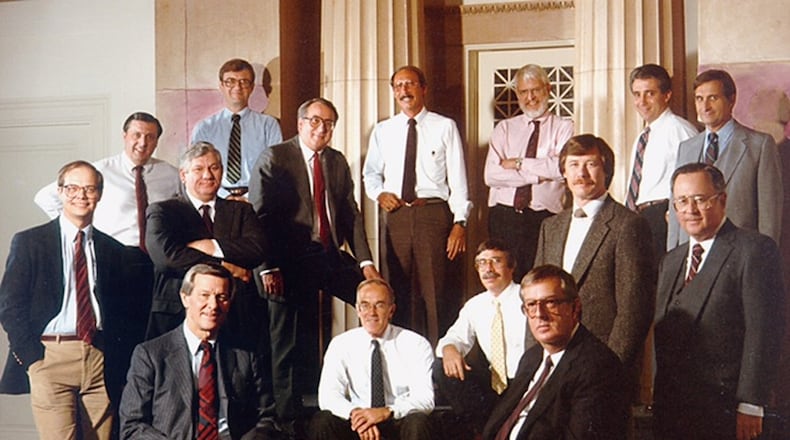“I’ve had a really nice career and I’ve had a wife who has really been wonderful, who allowed me to work and be involved enthusiastically with several organizations,” he said. “You would recognize many of those buildings we worked on. I certainly didn’t work on all of those buildings but had the good fortune to be associated with the firm that did.”
» BUSINESS FEATURE: Meet the 98-year-old Centerville man starting his own business
Some of the firm’s recent projects include: the Sycamore Medical Center Physician office building, Kettering Memorial Hospital Emergency Department, Aullwood Audubon Center, Springboro Community Amphitheater and the Boonshoft Center for Medical Sciences at Wright State University.
Roediger has put his touch on buildings across Dayton, Columbus and Cincinnati. After graduating from the University of Cincinnati in 1957, he returned to his hometown of Dayton to work for architecture firm W.W. Wurst after being stationed in North Carolina in the U.S. Air Force.
He joined Lorenz & Williams in 1963, where he spent the rest of his career and was named principal partner in 1970. He transitioned to the role of partner emeritus in 1998.
It was never just a job for Roediger. Growing up, his late mother Louetta Roediger was convinced he would one day work as an architect. Even in high school, the teenage boy kept building blocks under his bed and would pull them out to construct his dream buildings.
“I’d give the same advice to anybody, an architect or any other career. If possible, find a job or career that you enjoy,” he said. “Architecture isn’t a get-rich scheme. It’s something you really need to enjoy, do it well and you’ll look forward to going to work every day. I’ve been really lucky in that regard.”
During his career, he won several awards for his notable projects. From the renovation of the Victoria Theatre to the Columbus Convention Center, Roediger said he aimed to create “good work that’s dedicated to the right solution for the client.”
Of course, the building should sustain itself and prove to be “handsome” as it ages, he said. Roediger quite frequently referred back to Roman architect Vitruvius Pollio’s three elements for a well-designed building: firmness, commodity and delight.
Roediger also worked with renowned architect Peter Eisenman to create an addition to the acclaimed building home to the University of Cincinnati College of Design, Architecture, Art and Planning building — his alma mater.
The addition won an award from Progressive Architecture magazine, and the award jury said it “admired the way the UC program managed to be at once abstract and site-specific, conceptual yet contextual. Based upon a series of geometrical transformations, the building will curve up a hillside into a fragmented form and blurred image that architects see as symbolic of the human condition in this media-dominated information age,” according to archives from the Dayton Daily News.
» BUSINESS FEATURE: Fred Weber leaves leadership legacy as Kettering jewelry store closes
“With its many angles and unusual geometry, we struggled but it got done,” he said. “It took forever. I’m glad the students like the result.”
His other work includes The Colossus roller coaster at Magic Mountain Park in California, the Old Dayton Post Office renovation, Kettering Tower, the NCR Microelectronics Research Facility and several department stores. He spent a large portion of his career designing buildings for healthcare companies like Premier Healthcare and Kettering Health Network.
“(My work) has truly been one of those things that has been blessed in my life,” he said. “I have a wonderful life and family and I’ve enjoyed my career. I’ve received more than I’ve given.”
Along the way, he grew a family with his wife, Johanna, and their four sons — giving credit to his wife for raising fine men and supporting his ambitions. Beyond his architectural prowess, Roediger contributed to his community by serving on the boards of organizations like the United Theological Seminary, United Way of Greater Dayton, Trotwood-Madison Board of Education and the Victory/Victoria Theatre Association.
“He was personable, caring and gracious, with a wry sense of humor that helped him build lasting relationships. In 2006, when United relocated to the old Jewish Community Center on Denlinger Road, Dick played an integral role in the development, design and build-out of our new campus,” said Ed Zeiders, former president of United Theological Seminary and chair of United’s Advisory Council. “His countless contributions to the community, not just as an architect but also as a responsible citizen, will continue to impact lives for years to come.”
In retirement, he plans to read feverishly — mostly American history, because there’s too much history to learn, he says — and spend time with his wife in their home in Clayton.
Now, he passes the torch onto the next generation of visionaries and architects. His advice to those just starting their careers comes from one of his favorite poems, “Keep A-Pluggin’ Away,” by American novelist Paul Laurence Dunbar. On more than one occasion, it’s the advice that has guided him through — and that he’s passed along to his sons.
“Keep on plugging. When things get tough, keep on plugging,” Roediger said. “I think that’s true.”
About the Author


